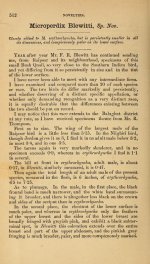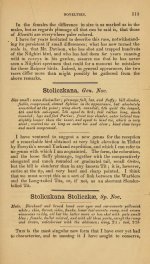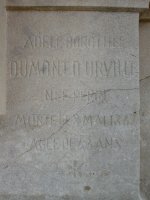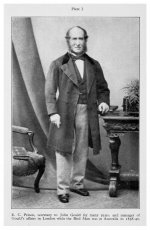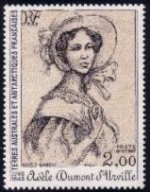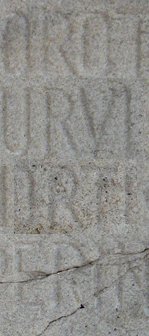Björn Bergenholtz
(former alias "Calalp")

Here´s a first list of some small additional information regarding the Etymology of ten various Bird Names that I´ve happened to stumble upon trying to understand various Swedish Bird Names … for your sake (as well as I can?) in English.
As far as I understand the following birds commemorates the following persons (… and one geographical place):
No. 1 – princei in …
● Grey Ground-Thrush Zoothera princei SHARPE 1874: "This new species is dedicated to my old valued friend Mr. Edwin C. Prince, for more than forty years the faithful coadjutor of Mr. John Gould."
= the British naturalist and Secretary and business manager (to precisely John Gould): Edwin Charles Prince (1809–1874), born in London in 1809 ... died of bronchitis 1874 at his home in London, aged 65. More on him, see link (here).
No. 2 – zelebori in …
● The subspecies Pardirallus sanguinolentus zelebori PELZELN 1865.
= the Austrian, Ornithologist, Conchyologist, Master Joiner ("Tischlermeister"), Hunter and taxidermist: Johann Zelebor (1815–1861), born 5th December 1815, in Eggenburg, Niederösterreich, Austria … and died in 1869.
See Obituary: von Pelzeln, A. 1889. Zur Erinnerung an heimgegangene Ornithologen. "Die Schwalbe": Mittheilungen des Ornithologischen Vereines in Wien 13: 604- 606. (attached)
No. 3 – blewitti in …
● The recently rediscovered (1997) Forest Owlet (Athene) Heteroglaux blewitti HUME 1873 a k a "Blewitt's owl".
● the subspecies Perdicula erythrorhyncha blewitti HUME 1874.
= the almost unknown British collector: Francis Robert Blewitt (b. 1815), living in British India, at least until 1872/1873. Original descriptions, on both the Generic name Heteroglaux and "Blewitti" (as well as further discussion) on other Bird Forum thread (here).
The same "Mr. F. R. Blewitt" also procured the type specimen of the then unknown Bush Quail, described as "Microperdix Blewitti". See type description, in Stray Feathers 1874 (attached).
This Francis Robert Blewitt (that I think normally was called Robert) was the older brother to William Turnbull Blewitt (1816-1889) and Henry Blewitt (b. 1817), and (later on, in his father's second marriage) to his half-brothers Francis Colwell (b. 1827) and Thomas (b.1836). Not to be confused with his (or their) father (and namesake!) Francis Robert Blewitt (1787–1836), long gone by the time this first mentioned "F. R. Blewitt" shot both the little Owlet and the little Quail. They all were living in British India. In more detail, according to a List of Hume's correspondents, "F. R. Blewitt" lived in "Raipur, Jhansi". That´s about all I´ve been able to find on this man!
No. 4 – abdimii in …
● Abdim's Stork Ciconia abdimii LICHTENSTEIN 1823.
= the (fairly unknown among Ornithologist's, but fairly known among Colonial War Historians) Albanian officer: Mr. Abidin (about 1780–1827), whose full name nobody seem to know – a k a "Abidin Bey al-Arnaut" literarly written Ābidīn alt. Ābidīn Bey al-Arnā’ūt (and as if that wasn´t enough) a k a (in a multitude of various languages, interpretations and transcriptions, due to various spelling rules alt. traditions of how to treat and write Ariabian, as in this his "Arabic" name; "Abdin Bey al-Arnaut", "Bey El-Arnaut Abdim", "El Arnaut Abdim Beğ", "Bey-Abdim", "Abdim-bey" as well as just "Abdim beg" or "Abdim beğ"
… among friends and those who knew him as ”Abdi” (Ābdī) – Turkish-Egyptian Governor of Dongala in Egyptian Sudan, that was killed by (his own!) Turkish soldiers in an up-rising 1827 in the city of Manfalut on the Nile.
Is the abdimii simply a misinterpretation of his name (?) or could the the ending -mii part (in abdimii) have something to do with the Latin masculine vocative singular of the pronoun meus ("mine") … in relation to his "nick-name", what he was called; "Abdi" as in abdi-mi-i … ?! Me, not being a Latin scholar, just wonder: Is such a latinized combination even possible?
Homever: the two Germans Wilhelm Hemprich and Christian Gottfried Ehrenberg collected the type just outside Dongala in the summer of 1822. It was described, on their behalf (in litteris), by Lichtenstein 1823: "Habitat satis frequens mense Majo Junio ad Nilum prope Dongolam, a peregrinatoribus borussicis in honorem Abdimii Principis, qui a patre Mehemed Ali Nubiae provinciam tenet, hoe nomine insignita....".
Which one of the tree men that caused the misunderstanding of his actual name we´ll probably never know. And talking about his "name"; the Bey (sometimes, in various transcriptions to/from different langages also written beg or beğ) is a an honorary title (literally meaning "Mister" alt. "Master", but here; leader, chief or even "prince") and El-Arnaut simply means "the Albanian"!
No. 5 – lidthi in …
● Lidth's Jay Garrulus lidthi BONAPARTE 1850
= the Dutch professor: Theodoor Gerhard van Lidth de Jeude (1788–1863), often (in English) written as Theodore or latinized as Theodorus ….
I´ve found no confirmation of his sometimes claimed second first name "Willem" ... !?
No. 6 – apperti in …
● Appert's Greenbul (Phyllastrephus/Bernieria) Xanthomixis apperti COLSTON 1972 a k a "Appert's Tetraka".
= the Swiss Priest and catholic Missionary , Paleontologist, Zoologist and Collector: Otto Appert (1930–2012), who collected the type specimen there on the 4th of September 1962).
Otto Appert was born on 31 August 1930 in Zürich, Switzerland, and visited Madagascar repeatedly, between 1859 and 1988, when he returned to Switzerland for good. He died in Ruswill Switzerland on 29 May 2012. See: Langrand, O. 2013. Obituary Otto Appert 1930-2012 Bulletin of the African Bird Club 20 (1): 112-113.
No. 7 – adeliae in …
● Adelie Penguin Pygoscelis adeliae HOMBRON & JACQUINOT 1841 (a k a "Adélie Penguin")
= the French territory La Terre Adélie (Adélie Land), Antarctica – which is (in its turn) named after the Wife of the French Explorer Vicomte (viscount) Dumont d’Urville: Vicomtesse (viscountess) Adele (no accent either way) Dorothee Dumont d’Urville, born Perin (xxxx–1842), that died in a train crash (with her sons and more famous husband) on the 8th of May 1842.
On her Tombstone in the cemetery Cimetière Montparnasse in Paris it states "AGGEE DE 43" ("in the age of 43"). Not even her own family seem to know exactly when she was born!? (See attached jpg)
No. 8 – anchietae in …
● Anchieta's Sunbird Anthreptes anchietae BOCAGE 1878.
= the Portuguese explorer, naturalist and collector José Alberto de Oliveira Anchieta (1832–1897), that collected in Angola and Mozambique for more than 30 years – until his death in Malaria. He collected the type specimen in 1877, Southwest Angola.
The same Anchieta is also (according to various sources, I haven´t checked them) commemorated in:
● Anchieta's Barbet (Buccanodon) Stactolaema anchietae BOCAGE 1869.
● Anchieta's Tchagra (Tchagra/Antichromus) Bocagia (minuta/minutus) anchietae BOCAGE 1869.
● the subspecies (Phoeniculus) Rhinopomastus aterrimus anchietae BOCAGE 1892.
Not to be confused with the much earlier Spanish Priest José de Anchieta (1534–1597) a k a "the Apostle of Brazil" (which is done a lot, on the Internet, especially regarding Pictures of him!).
No. 9 – bartletti in …
● Bartlett's Tinamou Crypturellus bartletti SCLATER & SALVIN 1873.
● subspecies (Polyerata) Amazilia lactea bartletti GOULD 1866.
= the relatively unknown British Ornithologist, taxidermist, traveler and collector and later Museum administrator Edward Bartlett (1844–1908), that discovered and collected (quite a few specimens, incl. the Type) of the Tinamou in Peru. The same "E. Bartlett" also collected 7 specimens (incl. the Type) of this subspecies.
Not to be confused with his much more well-known father Abraham Dee Bartlett (1812–1897), that probably, most likely (!) is the one commemorated in the extinct (at least in the Wild) sub-species "Bartlett's Bleeding-heart " Gallicolumba crinigera bartletti SCLATER 1863.
No. 10 – Malimbe and Malimbus in …
● All different Malimbe's, as well as the Generic name Malimbus VIEILLOT 1805, origins from specific name "Le Tangara de Malimbe" firstly described as "Tanagra malimbica" (today Crested Malimbe Malimbus malimbicus DAUDIN 1802): " …à Malimbe, ville du royaume de Congo, sur la côte dʼAfrique ..."
= the small village Malimbe (probably equal of today's Malembo, with roughly 500 inhabitants) on the Northern Coast of Angola
Anyone of a different view?
Björn Bergenholtz, Stockholm, Sweden
PS. And, just for the fun of it … attached is a photo of No. 1: Mr. Prince!
As far as I understand the following birds commemorates the following persons (… and one geographical place):
No. 1 – princei in …
● Grey Ground-Thrush Zoothera princei SHARPE 1874: "This new species is dedicated to my old valued friend Mr. Edwin C. Prince, for more than forty years the faithful coadjutor of Mr. John Gould."
= the British naturalist and Secretary and business manager (to precisely John Gould): Edwin Charles Prince (1809–1874), born in London in 1809 ... died of bronchitis 1874 at his home in London, aged 65. More on him, see link (here).
No. 2 – zelebori in …
● The subspecies Pardirallus sanguinolentus zelebori PELZELN 1865.
= the Austrian, Ornithologist, Conchyologist, Master Joiner ("Tischlermeister"), Hunter and taxidermist: Johann Zelebor (1815–1861), born 5th December 1815, in Eggenburg, Niederösterreich, Austria … and died in 1869.
See Obituary: von Pelzeln, A. 1889. Zur Erinnerung an heimgegangene Ornithologen. "Die Schwalbe": Mittheilungen des Ornithologischen Vereines in Wien 13: 604- 606. (attached)
No. 3 – blewitti in …
● The recently rediscovered (1997) Forest Owlet (Athene) Heteroglaux blewitti HUME 1873 a k a "Blewitt's owl".
● the subspecies Perdicula erythrorhyncha blewitti HUME 1874.
= the almost unknown British collector: Francis Robert Blewitt (b. 1815), living in British India, at least until 1872/1873. Original descriptions, on both the Generic name Heteroglaux and "Blewitti" (as well as further discussion) on other Bird Forum thread (here).
The same "Mr. F. R. Blewitt" also procured the type specimen of the then unknown Bush Quail, described as "Microperdix Blewitti". See type description, in Stray Feathers 1874 (attached).
This Francis Robert Blewitt (that I think normally was called Robert) was the older brother to William Turnbull Blewitt (1816-1889) and Henry Blewitt (b. 1817), and (later on, in his father's second marriage) to his half-brothers Francis Colwell (b. 1827) and Thomas (b.1836). Not to be confused with his (or their) father (and namesake!) Francis Robert Blewitt (1787–1836), long gone by the time this first mentioned "F. R. Blewitt" shot both the little Owlet and the little Quail. They all were living in British India. In more detail, according to a List of Hume's correspondents, "F. R. Blewitt" lived in "Raipur, Jhansi". That´s about all I´ve been able to find on this man!
No. 4 – abdimii in …
● Abdim's Stork Ciconia abdimii LICHTENSTEIN 1823.
= the (fairly unknown among Ornithologist's, but fairly known among Colonial War Historians) Albanian officer: Mr. Abidin (about 1780–1827), whose full name nobody seem to know – a k a "Abidin Bey al-Arnaut" literarly written Ābidīn alt. Ābidīn Bey al-Arnā’ūt (and as if that wasn´t enough) a k a (in a multitude of various languages, interpretations and transcriptions, due to various spelling rules alt. traditions of how to treat and write Ariabian, as in this his "Arabic" name; "Abdin Bey al-Arnaut", "Bey El-Arnaut Abdim", "El Arnaut Abdim Beğ", "Bey-Abdim", "Abdim-bey" as well as just "Abdim beg" or "Abdim beğ"
… among friends and those who knew him as ”Abdi” (Ābdī) – Turkish-Egyptian Governor of Dongala in Egyptian Sudan, that was killed by (his own!) Turkish soldiers in an up-rising 1827 in the city of Manfalut on the Nile.
Is the abdimii simply a misinterpretation of his name (?) or could the the ending -mii part (in abdimii) have something to do with the Latin masculine vocative singular of the pronoun meus ("mine") … in relation to his "nick-name", what he was called; "Abdi" as in abdi-mi-i … ?! Me, not being a Latin scholar, just wonder: Is such a latinized combination even possible?
Homever: the two Germans Wilhelm Hemprich and Christian Gottfried Ehrenberg collected the type just outside Dongala in the summer of 1822. It was described, on their behalf (in litteris), by Lichtenstein 1823: "Habitat satis frequens mense Majo Junio ad Nilum prope Dongolam, a peregrinatoribus borussicis in honorem Abdimii Principis, qui a patre Mehemed Ali Nubiae provinciam tenet, hoe nomine insignita....".
Which one of the tree men that caused the misunderstanding of his actual name we´ll probably never know. And talking about his "name"; the Bey (sometimes, in various transcriptions to/from different langages also written beg or beğ) is a an honorary title (literally meaning "Mister" alt. "Master", but here; leader, chief or even "prince") and El-Arnaut simply means "the Albanian"!
No. 5 – lidthi in …
● Lidth's Jay Garrulus lidthi BONAPARTE 1850
= the Dutch professor: Theodoor Gerhard van Lidth de Jeude (1788–1863), often (in English) written as Theodore or latinized as Theodorus ….
I´ve found no confirmation of his sometimes claimed second first name "Willem" ... !?
No. 6 – apperti in …
● Appert's Greenbul (Phyllastrephus/Bernieria) Xanthomixis apperti COLSTON 1972 a k a "Appert's Tetraka".
= the Swiss Priest and catholic Missionary , Paleontologist, Zoologist and Collector: Otto Appert (1930–2012), who collected the type specimen there on the 4th of September 1962).
Otto Appert was born on 31 August 1930 in Zürich, Switzerland, and visited Madagascar repeatedly, between 1859 and 1988, when he returned to Switzerland for good. He died in Ruswill Switzerland on 29 May 2012. See: Langrand, O. 2013. Obituary Otto Appert 1930-2012 Bulletin of the African Bird Club 20 (1): 112-113.
No. 7 – adeliae in …
● Adelie Penguin Pygoscelis adeliae HOMBRON & JACQUINOT 1841 (a k a "Adélie Penguin")
= the French territory La Terre Adélie (Adélie Land), Antarctica – which is (in its turn) named after the Wife of the French Explorer Vicomte (viscount) Dumont d’Urville: Vicomtesse (viscountess) Adele (no accent either way) Dorothee Dumont d’Urville, born Perin (xxxx–1842), that died in a train crash (with her sons and more famous husband) on the 8th of May 1842.
On her Tombstone in the cemetery Cimetière Montparnasse in Paris it states "AGGEE DE 43" ("in the age of 43"). Not even her own family seem to know exactly when she was born!? (See attached jpg)
No. 8 – anchietae in …
● Anchieta's Sunbird Anthreptes anchietae BOCAGE 1878.
= the Portuguese explorer, naturalist and collector José Alberto de Oliveira Anchieta (1832–1897), that collected in Angola and Mozambique for more than 30 years – until his death in Malaria. He collected the type specimen in 1877, Southwest Angola.
The same Anchieta is also (according to various sources, I haven´t checked them) commemorated in:
● Anchieta's Barbet (Buccanodon) Stactolaema anchietae BOCAGE 1869.
● Anchieta's Tchagra (Tchagra/Antichromus) Bocagia (minuta/minutus) anchietae BOCAGE 1869.
● the subspecies (Phoeniculus) Rhinopomastus aterrimus anchietae BOCAGE 1892.
Not to be confused with the much earlier Spanish Priest José de Anchieta (1534–1597) a k a "the Apostle of Brazil" (which is done a lot, on the Internet, especially regarding Pictures of him!).
No. 9 – bartletti in …
● Bartlett's Tinamou Crypturellus bartletti SCLATER & SALVIN 1873.
● subspecies (Polyerata) Amazilia lactea bartletti GOULD 1866.
= the relatively unknown British Ornithologist, taxidermist, traveler and collector and later Museum administrator Edward Bartlett (1844–1908), that discovered and collected (quite a few specimens, incl. the Type) of the Tinamou in Peru. The same "E. Bartlett" also collected 7 specimens (incl. the Type) of this subspecies.
Not to be confused with his much more well-known father Abraham Dee Bartlett (1812–1897), that probably, most likely (!) is the one commemorated in the extinct (at least in the Wild) sub-species "Bartlett's Bleeding-heart " Gallicolumba crinigera bartletti SCLATER 1863.
No. 10 – Malimbe and Malimbus in …
● All different Malimbe's, as well as the Generic name Malimbus VIEILLOT 1805, origins from specific name "Le Tangara de Malimbe" firstly described as "Tanagra malimbica" (today Crested Malimbe Malimbus malimbicus DAUDIN 1802): " …à Malimbe, ville du royaume de Congo, sur la côte dʼAfrique ..."
= the small village Malimbe (probably equal of today's Malembo, with roughly 500 inhabitants) on the Northern Coast of Angola
Anyone of a different view?
Björn Bergenholtz, Stockholm, Sweden
PS. And, just for the fun of it … attached is a photo of No. 1: Mr. Prince!
Attachments
Last edited:




